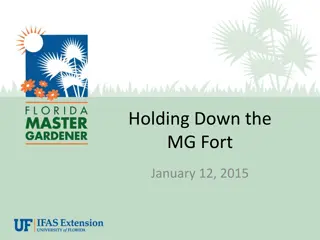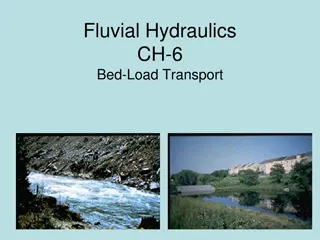Exploring Hugelkultur: A Sustainable Raised Bed Gardening Method
Hugelkultur is a unique gardening technique that mimics forest floor decomposition by creating raised garden beds using decaying wood covered with compost and soil. This method improves soil fertility, water retention, soil warming, and provides a nutrient-rich environment for plant growth. Despite its advantages, challenges such as nitrogen depletion and potential bed collapse need to be addressed for successful implementation.
Download Presentation

Please find below an Image/Link to download the presentation.
The content on the website is provided AS IS for your information and personal use only. It may not be sold, licensed, or shared on other websites without obtaining consent from the author. Download presentation by click this link. If you encounter any issues during the download, it is possible that the publisher has removed the file from their server.
E N D
Presentation Transcript
A tree falls in a forest Image a tree falling in forest. Leaves cover the log; as a result the wood retains moisture and begins to decay. Fungi, insects, amphibians move in and further break down the wood. Eventually the log collapses. It has become a long heap of compost. Vegetation, including trees, take advantage of the moist and nutrient rich environment. The fallen tree has become a nurse log .
What is Hgelkultur? H gelkultur is type of RAISED BED that tries to recreate forest floor decomposition H gelkultur is a method of creating raised garden beds by covering rotting wood with compost and soil, and then planting into them. H gelkultur is a composting process employing raised beds constructed from decaying wood debris and other compostable biomass plant materials. The process helps to improve soil fertility, water retention, and soil warming, thus benefiting plants grown on or near such mounds.* Wikipedia
Why build a hgelkultur? Advantages Drought resistant- rotting materials retain water Higher soil temperatures Encourages microbes Build fertility in the soil Twice the surface area for plants Pockets between materials avoid compaction
Comparison Hugel and traditional bed comparison. Cantaloupe plants from same seed packet. Hugel bed on right was planted two weeks after traditional bed on left.
Challenges of Hgelkultur Nitrogen Depletion --Counteracted by adding ramiel wood, compost, yard clippings Soil may need to be replenished after time- it subsides and will expose the logs if the initial amount of soil was not thick enough Needs some moisture particularly when getting established Bed eventually collapses--Hugelkultur sometimes called a 30 year raised bed
A word on nitrogen depletion When a log rots, the carbon immobilizes nitrogen in the surrounding area. I asked our UC soils guy Dr. Richard Smith. Here is his response. Yes, the high carbon in the log would immobilize nitrogen in the area of the log. The affect of the log can only extend a few inches in radius from the log though. Putting high nitrogen fertilizer or organic matter can make up for the immobilization.
How to build a Hgelkultur Dig a Trench Bottom layer: logs and thick twigs Next layer: a thick pile of dead leaves, dry straw Middle layer: lawn clippings, green leaves Penultimate layer: mature compost Top layer: topsoil 5-6
Type of wood to use in H gelkultur beds
Wood to avoid in Hgelkultures Some trees are allelopathic, that is, trees that produce inhibitors of seed germination and seedling growth in order to suppress competing undergrowth. Common allelopathic plants are Black Walnut, Pepper, Sycamore, American elm, Oaks, Sycamore, Manzanita California Bay laurel, Cottonwood, Forsythia, Tree-of-heaven, Black locust and Eucalyptus. Manzanita circle can be easily seen and means Don t plant here!
The next layers Cuttings; ramiel wood Straw; leaves; prunings Compost Cover with 5 to 6 inches of soil
What is ramial wood? Ramial wood or Chipped Branch Wood (CBW) is wood from branches less that 3 inches in diameter. What the researchers learned is that twigs less than three inches at the tips of deciduous tree branches contain soluble lignin, the base for soil aggregates which creates a long-lasting humus, regenerating and reactivating the soil structure. When this wood decomposes, the nutrients are released into the soil and become available to plants.*UCANR
Types of Hgelkulter beds Hay Bale FramePallet Frame Rock Border
Keyhole H gelkultur Spiral H gelkultur Raised Bed H gelkultur
Keyhole Gardens Idea from Africa
My Hgel Adventures In 2012 I put in a hugel at the top of a very steep slope
The Hgel mound has disappeared but the succulents are doing well
Another Hgel Experiment A maple planted on a steep slope did nothing for years. (It rarely gets watered) I created a Hugel berm below it. After 3 years the Hugel mound is a foot lower but the maple is doing well.
Whose idea is this? The term h gelkultur was coined by German horticulturalists Hans Beba and Herman Andra in the late 1970s. Roughly translated into hill culture , this method consists of creating raised garden beds by covering rotting wood with compost and soil, and then planting into them. Made popular by Permaculture guru Sepp Holzer.
Old school H gelkulture
Permaculture What is it? Permanent Agriculture A philosophy of designing land use on principals observed in natural systems, with an emphasis on ethics, responsibility to the earth, designing a landscape that maximizes the resources. Example of a permaculture design principal : hold water and fertility as high (in elevation) on the landscape as possible Some Design Ideas: Swales Hugelkultur Food Forest Keyhole garden
Swales Water Conservation design by Sepp Holzer
Contouring the land to conserve water runoff Swales Swales are berms that act as ditches to impede water flow
Caution: Hgelkulture Swales are not solid earthworks Swales are an excellent practice for preventing flooding. However, swales on steep slopes that are constructed using H gelkulture practices should not be considered effective dams. * *See wiki on the danger in mistaking H gelkultur mounds for solid earthworks
Typical Hgel Swale Swales are designed to keep the water where it falls that is, prevent runoff.
Hgelkulture in a demonstration garden























